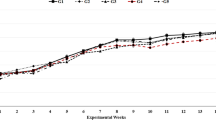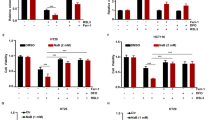Abstract
To investigate the role of reactive oxygen species (ROS) induced by butyrate in tumor cells, we compared HT29R, an HT29-derived human colon cancer cell line refractory to butyrate-induced cell differentiation but highly sensitive to cell death, with the differentiation-positive HT29-12 and HT29-21 cell lines (exhibiting low sensitivity to butyrate-induced cell death), with respect to levels of butyrate-induced free radicals (FRs), ROS, and H2O2. Dose-dependent increase of FRs (as determined by electron spin resonance spectroscopy) and ROS (dichlorofluorescein assay) was induced in HT29R, but not in HT29-12 and HT29-21 cells, where, in contrast to HT29R, a dose-dependent increase of H2O2 release (phenol red assay) was induced by butyrate. The mode of butyrate-induced cell death in HT29R cells was of a mixed type with necrosis predominating, which, however, switched to apoptosis as the major type of cell death in the presence of the drugs 1,5-dihydroxyisoquinoline, resveratrol, or cyclosporine A. The results suggest that FRs and ROS induced by butyrate in HT29R cells are products of cell death, while H2O2 induced in HT29-12 and HT29-21 cells is functionally related to cell differentiation.






Similar content being viewed by others
References
Giardina C, Inan MS. Nonsteroidal anti-inflammatory drugs, short-chain fatty acids, and reactive oxygen metabolism in human colorectal cancer cells. Biochim Biophys Acta. 1998;1401:277–288. doi:10.1016/S0167-4889(97)00140-7.
Ruefli AA, Ausserlechner MJ, Bernhard D, et al. The histone deacetylase inhibitor and chemotherapeutic agent suberoylanilide hydroxamic acid (SAHA) induces a cell-death pathway characterized by cleavage of Bid and production of reactive oxygen species. Proc Natl Acad Sci USA. 2001;98:10833–10838. doi:10.1073/pnas.191208598.
Rosato RR, Almenara JJ, Grant S. The histone deacetylase inhibitor MS-275 promotes differentiation or apoptosis in human leukemia cells through a process regulated by generation of reactive oxygen species and induction of p21 CIP1/WAF1. Cancer Res. 2003;63:3637–3645.
Moreira JMA, Scheipers P, Sørensen P. The histone deacetylase inhibitor trichostatin A modulates CD4+ T cell responses. BMC Cancer. 2003;3:30. http://www.biomedcentral.com/1471-2407/3/30. doi:10.1186/1471-2407-3-30.
Ungerstedt JS, Sowa Y, Xu WS, et al. Role of thioredoxin in the response of normal and transformed cells to histone deacetylase inhibitors. Proc Natl Acad Sci USA. 2005;102:673–678. doi:10.1073/pnas.0408732102.
Csordas A. Toxicology of butyrate and short-chain fatty acids. In: Hill MJ, ed. Role of Gut Bacteria in Human Toxicology and Pharmacology. London: Taylor and Francis; 1995:105–127.
Kruh J, Defer L, Tichonicky L. Effects of butyrate on cell proliferation and gene expression. In: Cummings JH, Rombeau JL, Sakata T, eds. Physiological and Clinical Aspects of Short-Chain Fatty Acids. Cambridge: Cambridge University Press; 1995:275–288.
Burgess A, Ruefli A, Beamish H, et al. Histone deacetylase inhibitors specifically kill nonproliferating tumour cells. Oncogene. 2004;23:6693–6701. doi:10.1038/sj.onc.1207893.
Lindemann RK, Gabrielli B, Johnstone RW. Histone-deacetylase inhibitors for the treatment of cancer. Cell Cycle. 2004;3:779–788.
Lesuffleur T, Violette S, Vasile-Pandrea I, et al. Resistance to high concentrations of methotrexate and 5-fluorouracil of differentiated HT-29 colon-cancer cells is restricted to cells of enterocytic phenotype. Int J Cancer. 1998;76:383–392. doi:10.1002/(SICI)1097-0215(19980504)76:3≤383::AID-IJC16≥3.0.CO;2-C.
Nicoletti I, Migliorati G, Pagliacci MC, Grignanai F, Riccardi C. A rapid and simple method for measuring thymocyte apoptosis by propidium iodide staining and flow cytometry. J Immunol Methods. 1991;139:271–279. doi:10.1016/0022-1759(91)90198-O.
Quaio L, Hanif R, Sphicas SJ, Shiff B, Rigas B. Effect of aspirin on induction of apoptosis in HT-29 human colon adenocarcinoma cells. Biochem Pharmacol. 1998;55:53–64. doi:10.1016/S0006-2952(97)00400-0.
Shulyakowskaya T, Sümegi L, Gál D. In vivo experimental studies on the role of free radicals in photodynamic therapy I. Measurement of the steady state concentration of free radicals in tumor tissues of mice. Biochem Biophys Res Commun. 1993;195:581–587. doi:10.1006/bbrc.1993.2085.
Baud L, Perez J, Ardaillou R. Dexamethasone and hydrogen peroxide production by mesangial cells during phagocytosis. Am J Physiol. 1986;250:596–604.
Sedlak J, Lindsay RH. Estimation of total, protein-bound, and nonprotein sulfhydryl groups in tissue with Ellman’s reagent. Anal Biochem. 1968;25:191–205. doi:10.1016/0003-2697(68)90092-4.
Kosower NS, Song KR, Kosower EM, Correa W. Glutathione II. Chemical aspects of azoester procedure for oxidation to disulfide. Biochim Biophys Acta. 1969;192:8–14.
Kirlin WG, Cai J, Thompson SA, Diaz D, Kavanagh TJ, Jones DP. Glutathione redox potential in response to differentiation and enzyme inducers. Free Radic Biol Med. 1999;27:1208–1218. doi:10.1016/S0891-5849(99)00145-8.
Zamareva MV, Sabirov RZ, Maeno E, Ando-Akatsuka Y, Bessonova SV, Okada Y. Cells die with increased cytosolic ATP during apoptosis: a bioluminescence study with intracellular luciferase. Cell Death Differ. 2005;12:1390–1397. doi:10.1038/sj.cdd.4401661.
Liu JJ, Huang BH, Zhang J, Carson DD, Hooi SC. Repression of HIP/RPL29 expression induces differentiation in colon cancer cells. J Cell Physiol. 2006;207:287–292. doi:10.1002/jcp.20589.
Butt AJ, Hague A, Paraskeva C. Butyrate- but not TGFβ1-induced apoptosis of colorectal adenoma cells is associated with increased expression of the differentiation markers E-cadherin and alkaline phosphatase. Cell Death Differ. 1997;4:725–732. doi:10.1038/sj.cdd.4400293.
Orchel A, Dzierżewicz Z, Parfiniewicz B, Węglarz L, Wilczok T. Butyrate-induced differentiation of colon cancer cells is PKC and JNK dependent. Dig Dis Sci. 2005;50:490–498. doi:10.1007/s10620-005-2463-6.
Pervaiz S, Clement MV. Superoxid anion: oncogenic reactive oxygen species? Int J Biochem Cell Biol. 2007;39:1297–1304. doi:10.1016/j.biocel.2007.04.007.
Burdon RH. Control of cell proliferation by reactive oxygen species. Free Radic Biol Med. 1995;18:775–794. doi:10.1016/0891-5849(94)00198-S.
Suzuki YJ, Forman HJ, Sevanian A. Oxidants as stimulators of signal transduction. Free Radic Biol Med. 1997;22:269–285. doi:10.1016/S0891-5849(96)00275-4.
Dröge W. Free radicals in the physiological control of cell function. Physiol Rev. 2002;82:47–95.
Acknowledgments
This research was supported by grants of the Hungarian Research Fund OTKA K 76133, OTKA T 49753, and the Österreichische Forschungsgemeinschaft (Project MOEL 339). We are indebted to Ms. Rajam Csordas-Iyer for critical reading and linguistic corrections.
Author information
Authors and Affiliations
Corresponding author
Rights and permissions
About this article
Cite this article
Domokos, M., Jakus, J., Szeker, K. et al. Butyrate-Induced Cell Death and Differentiation Are Associated with Distinct Patterns of ROS in HT29-Derived Human Colon Cancer Cells. Dig Dis Sci 55, 920–930 (2010). https://doi.org/10.1007/s10620-009-0820-6
Received:
Accepted:
Published:
Issue Date:
DOI: https://doi.org/10.1007/s10620-009-0820-6




